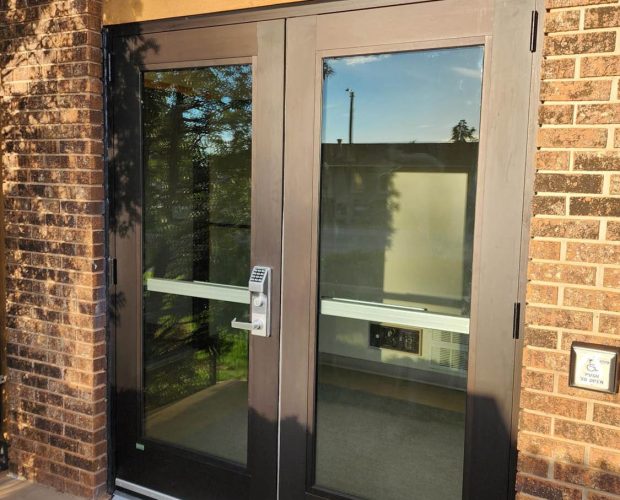Access Control
Security & Access Control
Architectural Specialties provides electronic security design, sales, installation, and service of multiple security platforms in the commercial market. Our services include access control, video surveillance, and intrusion detection. As one of the premier integrators of the region, Architectural Specialties can combine your electronic security needs into one seamless package. As part of the Architectural Specialties umbrella, our electronic security specialists are uniquely qualified to integrate electronic security with mechanical door hardware and electrical door components such as automatic openers and sliding doors.
With factory-trained and certified technicians on staff in Rapid City, SD and Gillette, WY we install only the industry’s leading manufacturers’ equipment. Our manufacturers include RS2 Technologies, Salient, Assa Abloy wireless, Axis, Inovonics, and Bosch.
The primary goal at Architectural Specialties is to provide our customers with a cost-effective complete security system designed to function to your specifications. Our design team is ready to sit down and find the solution best suited to your needs. We have offices in both Rapid City, SD, and Gillette, WY.
We’ve installed access control systems for businesses throughout the Black Hills and Wyoming. Take a look at just a few of them below:

access control FAQs
Access control is a method of granting personnel access to specific areas of a facility without the use of hard keys.
Access control is important because it helps to protect people and property by preventing unauthorized access. If unauthorized access is obtained it can provide real time reporting and notification of when the event occurred. When coupled with a video surveillance system it can reduce the time required to perform investigations into unauthorized entries into a building or space. It can also be used to track who is coming and going from a building or specific area, which is useful for security and safety purposes.
There are several different types of access control systems, including card access systems, biometric systems, pin code systems, and remote access systems. Each system has its own advantages and disadvantages, and the best system for a particular building or area depends on several factors, including the level of security required, the number of people who need access, and the budget.
The main benefit to investing is an access control system is the partial elimination of a hard key system for the facility and visitor control. The loss of a physical key or theft of a physical key could require the facility to rekey an entire building, costing thousands of dollars. Visitor control is improved by limiting non-employees to specific areas increasing the overall safety of the employees and the visitor themselves. A properly installed access control system increases overall security by providing the facility the ability to limit access to the building and provide the last known location of an employee or visitor in an emergency.
Choosing the right access control system depends on several factors, including the level of security required, the number of people who need access, and the budget. It’s important to work with a reputable security company to assess your needs and recommend the right system for your specific situation.
The installation requirements will vary depending on the type of access control system required. At a minimum devices will be located at each controlled access point. These devices will communicate with a central computer. This computer will store all required information for the access control system. Some devices may be hard wired while others may be wireless depending on the installation requirements. There are no real maintenance requirements for an access control system aside from power supply and wireless device battery replacement and routine software maintenance. As a general rule power supply batteries should be replaced annually to coincide with the buildings fire alarm system. Wireless device batteries will provide notifications when there levels drop below a reliable operational threshold. Software maintenance is in the form of routine updates for security patches and feature upgrades.
An access control system can be integrated with other existing systems with in the facility, including building controls, burglary, video surveillance and fire and time and attendance.
The access control system is normally managed by one or two individuals. These individuals will have full access to the system to assign credentials, determine access to specific doors and times they may be accessed. Other individuals within the company may be assigned limited use to the access control system to perform specific tasks such as creating credentials or assigning area specific access. In larger companies these responsibilities typically fall to the HR department.
Financing is an option, but a typical company will begin their access control system with one or two controlled openings and grow the system to fit it’s needs, requirements and budget. This approach allows the company to evaluate its next steps to determine if an access control system is right for their facility.



